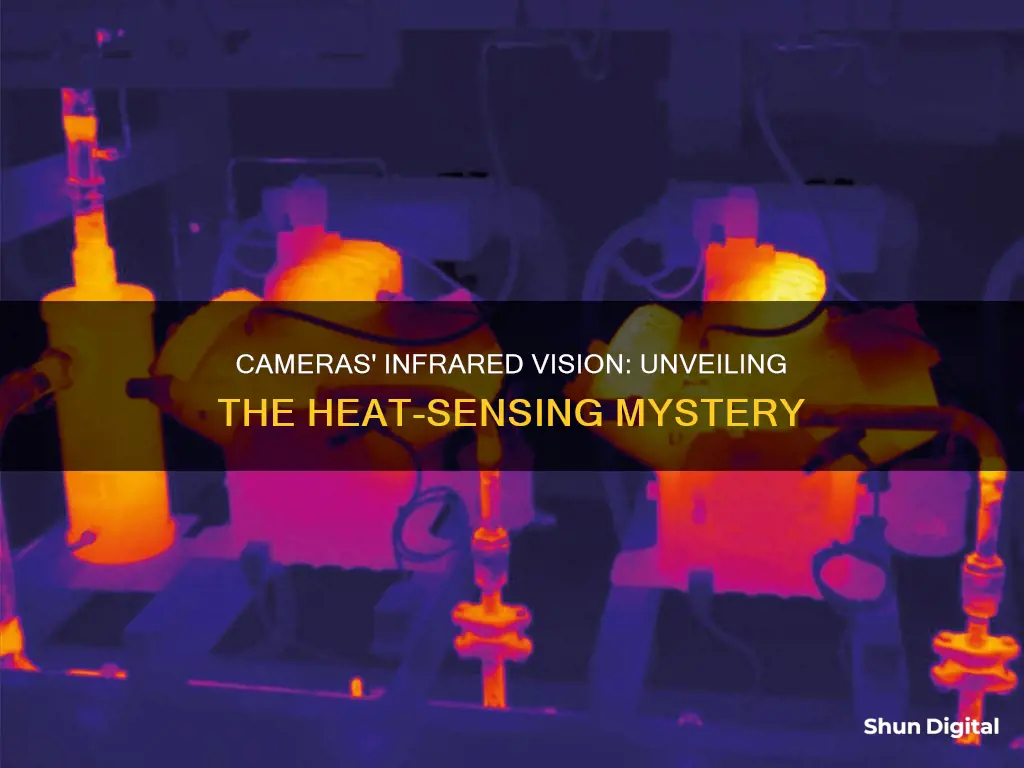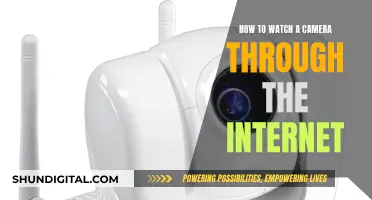
Thermal cameras, also known as infrared cameras, work by detecting heat energy from objects and creating an image from this information. All objects emit heat energy, which is measured by thermal cameras and translated into an image that represents the temperature of the object. This allows thermal cameras to see in the dark and in low-light conditions, and to detect the presence of people or objects that might be invisible to the human eye. Thermal cameras are used in a variety of fields, including security, emergency services, building maintenance, wildlife research, and more.
| Characteristics | Values |
|---|---|
| How do cameras see heat? | Cameras that can see heat use thermal imaging to detect and create an image of an object by sensing the heat energy or infrared radiation emitted by the object. |
| What is thermal imaging? | Thermal imaging is a process where a thermal camera captures and creates an image of an object by using infrared radiation emitted from the object. |
| How does thermal imaging work? | Thermal imaging cameras focus and detect the infrared radiation emitted by objects, then translate the temperature variations into a grayscale or color image. |
| What is infrared radiation? | Infrared radiation, also known as thermal energy, is a type of electromagnetic radiation emitted by all objects with a temperature above absolute zero. The amount of radiation emitted increases with temperature. |
| How is thermal imaging different from visible light photography? | Visible light photography relies on light bouncing off solid surfaces, while thermal imaging works by detecting heat energy, which can be done in complete darkness. |
| What are the advantages of thermal imaging? | Thermal imaging can be used in low-light or dark conditions, detect heat sources, identify targets in the dark, and see through some obscurants like smoke, dust, and light fog. |
| What are the limitations of thermal imaging? | Thermal imaging cannot see through glass, metal, or water, has limited resolution, and may not provide clear images of objects with uniform surface temperatures. |
| What are the applications of thermal imaging? | Thermal imaging is used in security, firefighting, wildlife tracking, building inspections, medical diagnostics, industrial maintenance, and more. |
What You'll Learn

How thermal cameras convert heat into images
Thermal cameras, also known as infrared cameras, are able to "see" heat by detecting and capturing infrared radiation (or heat signatures) emitted by objects. This process is called thermal imaging or thermography. All objects with a temperature above absolute zero emit thermal radiation, which is invisible to the human eye. However, thermal cameras can detect and convert this infrared energy into a visible light display or electronic signal, creating a thermal image that represents the temperature of the object.
The underlying technology behind thermal imaging cameras was first developed for military use. The process involves several steps:
- The thermal camera, equipped with an infrared detector, captures the infrared radiation emitted by objects within its field of view.
- The captured radiation data is then processed by the camera's built-in software and translated into an image.
- The software assigns different colours or shades of grey to represent different temperature values, creating a thermal image or thermogram.
- The resulting image is a detailed temperature map of the surveyed area, with warmer areas typically represented by shades of red and cooler areas by shades of blue.
Thermal cameras can detect even subtle differences in heat, as small as 0.01°C. This sensitivity allows them to identify objects or anomalies that stand out from their surroundings based on their temperature. For example, a person will appear lighter on a cold day as they are hotter than the background and darker on a hot day as they are cooler than the background.
Thermal imaging has a wide range of applications, including security and surveillance, building maintenance, industrial inspections, medical diagnostics, and firefighting. It is particularly useful in low-light or adverse weather conditions, as it does not rely on visible light to create images.
Access Yi Home Camera Footage on Windows 10
You may want to see also

The range of temperatures thermal cameras can detect
Thermal cameras can detect a wide range of temperatures, from as low as -50°C (-58°F) to as high as 2450°C (4442°F). The specific temperature range that a thermal camera can detect depends on the type of camera and its specifications.
Thermal cameras, also known as infrared thermographic cameras, work by capturing and creating an image of an object using infrared radiation emitted by the object. This process is known as infrared imaging science or thermography. All objects with a temperature above absolute zero emit infrared radiation, according to the black body radiation law. The amount of radiation emitted increases with temperature, so thermal cameras can detect variations in temperature.
Thermal cameras typically detect radiation in the long-infrared range of the electromagnetic spectrum, from 9,000 to 14,000 nanometers or 9 to 14 micrometres. This range is suitable for most applications, as it covers a wide temperature span.
There are two main types of thermal cameras: those with cooled infrared detectors and those with uncooled detectors. Cooled infrared detectors are typically contained in a vacuum-sealed case and cryogenically cooled to temperatures ranging from 4 Kelvin (-269°C) to just below room temperature. These cameras provide superior image quality, especially for objects near or below room temperature, but they are expensive and energy-intensive to operate.
Uncooled thermal cameras, on the other hand, use sensors that operate at ambient temperature or are stabilized at a temperature close to ambient. These cameras are smaller, less costly, and more energy-efficient than cooled infrared cameras. However, their resolution and image quality tend to be lower.
The resolution of a thermal camera's sensor, also known as the detector, determines the quality of the rendered image. Higher resolution cameras can measure smaller targets at greater distances and create sharper thermal images for more accurate measurements. The most widely used resolutions in industry include 80x80, 160x120, 382x288, and 640x480 pixels in long-wavelength infrared (LWIR) cameras, and 764x480 pixels in near-infrared (NIR) cameras.
In addition to the temperature range and resolution, other factors to consider when choosing a thermal camera include the field of view, sensitivity (Noise Equivalent Temperature Difference, NETD), spectral range, and ambient temperature and environment. The field of view refers to the extent of the scene that the camera can capture, while the NETD represents the smallest differential in temperature that the camera can measure. The spectral range is the range of wavelengths that the camera's sensor can detect, and it depends on the target material's emissivity, which is the proportion of thermal radiation emitted by the object due to its temperature.
Tracking Hockey: TV Cameras and the Puck
You may want to see also

The advantages of thermal imaging
Thermal imaging cameras work by capturing the heat energy emitted by objects and using it to create an image. This allows them to provide several advantages over traditional optical cameras.
Uncovering Hidden Issues
Thermal imaging can detect air leaks in a building, helping to maintain heating efficiency and reduce energy costs. It can also be used to identify moisture damage and assess its severity.
Enhanced Security
Thermal imaging cameras can detect the presence of people in situations where they might be invisible to the human eye or optical cameras, such as at night or in low-light conditions. This makes them ideal for security applications, as they can help detect intruders attempting to breach outdoor perimeters.
Detection of Electrical Faults
Thermal imaging can identify overloaded or overheating circuits and failing motor bearings. This enables timely repairs to be made, preventing damage to property or harm to occupants.
Speed of Response
Thermal imaging equipment can quickly and efficiently identify a wide range of faults within a building, saving time and money. Its portability and lightweight design make it convenient to move around during inspections, speeding up the process and ensuring accurate results.
Cost-Effectiveness
While thermal imaging may seem expensive, it can help identify areas where money is being wasted, such as energy leaks or faulty electrical systems. By addressing these issues, thermal imaging can make industrial buildings or homes more cost- and energy-efficient, ultimately saving money in the long run.
Watching Live Remote Cameras: A Step-by-Step Guide
You may want to see also

The limitations of thermal imaging
Thermal imaging is a highly useful technology with a wide range of applications, from firefighting to astronomy. However, it does have some limitations. Firstly, thermal imaging cameras are very expensive, which limits their use to large companies, public services, and educational institutions. The high cost also means there is a lack of training available for those using the technology, which can lead to misinterpretation of results.
Another drawback of thermal imaging is that it is affected by external factors such as weather conditions and the emissivity and reflectivity of surfaces. For example, rain and wind can impact the accuracy of thermal images, and the technology cannot see through glass or walls. Objects with erratic temperatures can also be difficult to interpret accurately, and most thermal cameras have an accuracy of +/-2% or worse for temperature measurement.
Furthermore, thermal imaging cameras are not suitable for studying underwater objects or objects with temperatures below -50°C (-58°F). They also cannot see through shiny or reflective surfaces, as thermal energy is reflected off them.
Finally, thermal imaging cameras have lower resolution than optical cameras, typically only 160 x 120 or 320 x 240 pixels, although higher-end models can achieve a resolution of 1280 x 1024 pixels.
Viewing Doorbell Camera Footage: TV Integration Options
You may want to see also

The history of thermal imaging
The Discovery of Infrared Radiation
In 1800, astronomer Sir William Herschel (1738-1822) was studying the sun's surface and its spots for the Royal Society of London. He used plates of darkened glass of different colours (light filters) to reduce the sun's glare when observing it through a telescope. Herschel noticed that some plates were warmer than others, leading him to hypothesise that temperature depends on the colour of light. To test this idea, he divided sunlight into a spectrum using a glass prism and measured the temperature of each section of light with a thermometer. He discovered that the temperature increased from violet to red light and, surprisingly, continued to increase beyond the red light sector. This led him to conclude that there were invisible rays of light beyond red light, which he termed "radiant heat" or "heat rays". The term "infrared" was coined later in the 19th century.
Early Infrared Research
In the early 19th century, scientists and researchers further explored the properties of infrared radiation. Italian researcher Landriani, in 1777, observed that the heating effect increased from the violet to the red end of the spectrum. Herschel, however, was the first to recognise that there must be a point beyond the red end where the heating effect reaches its maximum. He termed this discovery the "thermometrical spectrum" or, occasionally, "dark heat" or "the invisible rays".
The Birth of Thermal Imaging
The development of thermal imaging technology can be traced to the late 19th and early 20th centuries. During this period, scientists began experimenting with methods for sensing and detecting infrared radiation. Early attempts included using thermocouples, platinum black, and other materials to manufacture infrared detectors. These devices laid the foundation for future advancements in infrared imaging.
World War II and Military Applications
Infrared technology became crucial during World War II, especially for military applications such as night vision devices and missile guidance systems. This drove rapid advancements in infrared detection and imaging. The first infrared camera was built in 1929 by the British Army for anti-aircraft operations following World War I. The military quickly adopted thermal imaging, and it became an integral part of defence strategies in Europe and North America.
Post-War Developments
After World War II, companies like Texas Instruments, Hughes Aircraft, and Honeywell began developing single-element detectors that could scan scenes and produce linear images. However, due to high costs and technical limitations, the military initially decided not to pursue this technology. It wasn't until the late 1950s and early 1960s that these detectors were further improved and commercialised for military use.
Modern Thermal Imaging
In the latter half of the 20th century, advancements in semiconductor and infrared detector technologies led to the widespread use of modern infrared thermography. These improvements enabled the development of thermal imaging cameras that could capture infrared radiation and convert it into visible images. Thermal imaging technology found applications in various fields, including medicine, architecture, industry, and security.
Viewing Roku's Camera Feed on Your TV
You may want to see also
Frequently asked questions
Thermal cameras "see" heat by detecting the infrared radiation emitted by all objects with a temperature above absolute zero. This radiation is then translated into an image that portrays objects using their radiated heat instead of their visible properties.
Thermal cameras detect heat through the use of special lenses and sensors that focus on and detect electromagnetic radiation in the mid-wave and long-wave infrared ranges.
Thermal images typically display heat through the use of grayscale or colour profiles, with brighter shades of grey or colours like yellow representing hotter objects, and darker shades of grey or colours like blue representing cooler objects.
Thermal cameras are incredibly useful because they can detect infrared radiation emitted by all objects, regardless of lighting conditions. This makes them highly reliable and efficient, as they can detect heat sources and identify targets in the dark.







